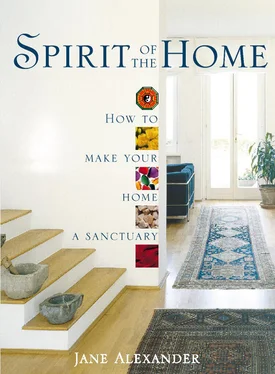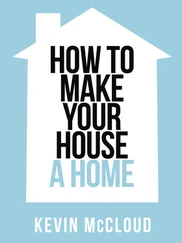We cannot achieve true peace of mind and spirit unless we reconnect with our homes at this deeper level. Without a true home we have no barrier between us and the ever-increasing stress of everyday life and work. A home with a heart embraces us when we walk through the door; we can almost feel it wrap its healing around us. Its aim and purpose is to protect and soothe, to bring us home in every sense. So one of the most important tasks we can perform for our physical and psychological health is to, quite literally, come home.
THE ART OF HOME-MAKING
But we seem to have lost the old instinctive art of home-making in its truest, most ancient form. We know how to arrange pictures but not how to make a house feel warm and welcoming. We are experts in knocking out fireplaces but amateurs when it comes to putting in atmosphere and feeling. Looking at the often sterile spaces we call home can be depressing and can bring on feelings of hopelessness. But we can easily change the situation. Our home-making skills haven’t really been lost – they are simply crafts which have become rusty through disuse. We can swiftly relearn the steps to creating a true home, to ensouling the home. All it takes is a little time and effort – and a large dose of imagination and wonder. What is needed is nothing less than the re-enchantment of our homes – to endow them with magic, warmth and joy. We need to bring back the life and soul of the home, honour its power and healing, respect its spirit.
It’s a case of relearning the old ways: how to cleanse not just the physical fabric of the house, but its spiritual energy too; how to sense and alter atmosphere; how to intuit what your home needs and what it doesn’t want at all. Rediscovering the spirit of your home is about bringing the natural world into your space, giving play to all the elements and the life force they embody. It’s about allowing your senses lull rein: filling your home with delicious sounds and scents, textures and tastes.
On an even deeper level, the spirit of your home can help you find out about yourself – who you are and who you’d like to be. Your home represents who you are, and by changing your surroundings you can certainly start the process of becoming someone closer to your true, authentic Self. It’s a journey of discovery and transformation that can alter your entire life. Finally, you arrive back where you always wanted to be. You come home.
I know it’s true because I’ve seen it and felt it and experienced it myself. I’ve lived in places without soul: they have felt lost and empty and I have felt lost and empty living in them. I’ve worked in buildings which have truly been ‘sick’ – and the people who worked in them were often depressed and frequently sick themselves. On the other hand, I have walked into places which are just so ‘right’, so totally imbued with spirit that my soul almost sighed with pleasure. These are the kinds of place in which you feel instantly at home. You can drop off your cares at the threshold and sink into a sacred space of peace, a true sanctuary.
The aim of this book is to show you how to turn a simple home into just that, a true sanctuary, a place of laughter, joy, peace and welcome. Many of the ideas in this book are almost too obvious to be true: They are simple, straightforward common sense. You’ll have that feeling of ‘well, of course, I knew that’ – and you did, you do. We all know this information at some level in our psyche because it is our common heritage. Whether you believe in past lives, the collective unconscious or the simple laws of genetics, we have all venerated the home in our pasts: we have all nurtured the sacred flame of the hearth, the symbolic Mother, the earth. At some level in our psyche we know all about honouring the spirits of the home, of ‘cleansing’ space as well as cleaning floors, of filling a sacred space with healing colour, sound and light.
But at a more conscious level we are maybe not so sure. While much of this book is common-sense, other ideas might sound far-fetched and even ludicrous to those with an overly rational mind. I tend to talk in terms of archetypes (because I happen to feel very comfortable with Jung’s work and these concepts). I also happily talk about subtle energy because I have felt it move both in my body and in my home. If you find such esoteric ideas difficult, don’t worry. You can still have a healing, soulful home without understanding or even believing a word of the theory or the mystical side of the equation.
Use this book as a resource, an ideas manual – dip in and out of it as you like. If you become bogged down in theory, psychology and mythology simply skip Part One. I would suggest you spend some time with Part Two if you can, because I’ve found that thinking about home in the ways suggested there can really change the way you look on yourself and your expectations of home. But, again, it’s not totally necessary. If you’re a really down-to-earth kind of person who just wants to get on with it, head straight for Part Three which is where the pure practical work begins.
PUTTING THE HEART INTO HOME
When I talk about these ideas of home to people, their first reaction is almost always to say, ‘Well, it would all be fine if I could have my ideal home.’ Or ‘If I had enough money I would have the perfect home.’ The grass is always greener … Interestingly, when you start really thinking about home and how it reflects your personality, you may find that you no longer think this way. I always craved bigger and better houses – which were also inevitably much more expensive. Having worked through many of the exercises which eventually formed those given in Part Two, I found I no longer wanted the big grand houses. I realized that I had been projecting a false image of myself out into the world through the houses I desired. Now I no longer crave anything bigger or grander – in fact, my next home will probably be far less imposing than my present place. But I will make sure it reflects my psyche and soul. Clare Cooper Marcus, who has written a wonderful book on the psychology of home, Houses as a Mirror of Self, makes this point beautifully. She spoke to all kinds of people about their homes and reports, ‘Some people were wealthy enough to own two houses but felt at home in neither of them. Others lived in great contentment in a single room or an illegal self-built shack.’
So money isn’t the stumbling block. But you will need to allow your home some time, effort and serious thought – along with a fair amount of elbow grease. Trust me – it’s really worth all the effort. Let me give you the example of my own home. When I moved in it was in a sorry state. Half of a large, early-Victorian rectory, it had been neglected for years. My husband, Adrian, and I turned up on the day of moving in and met a catalogue of woes. At first the house wouldn’t even let us in – the front door stuck fast and the key would not budge. When we finally forced the door we were greeted by a horrible smell – the toilets had blocked. We walked into one of the bedrooms and the ceiling caved in. A strange noise was coming from another end of the house: we raced up there and found boiling hot water pouring down the walls – the boiler had overheated.
By this point we were close to walking straight out again but we had fallen in love with the grand old house and the papers were signed so we shrugged our shoulders and decided to go ahead with our celebration champagne and take-away curry. We lit some candles, started a cosy fire and sat down to toast our (hopeful) happiness in our new home. Within seconds the fire was gorging smoke throughout the room and, choking, we ran to open the shutters. They stuck fast. When we finally man-handled them open, the windows themselves wouldn’t budge.
Читать дальше











